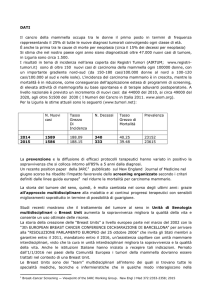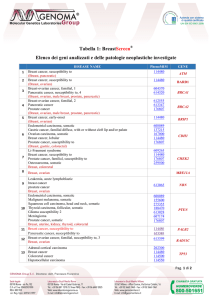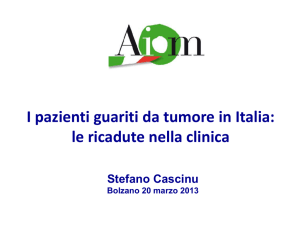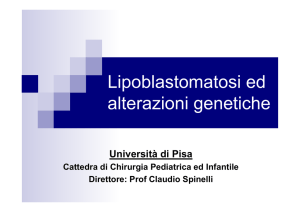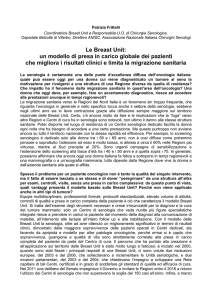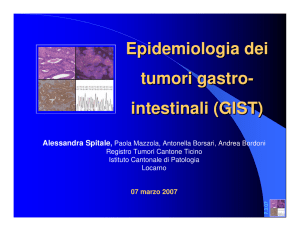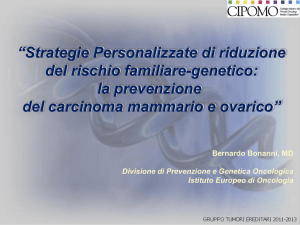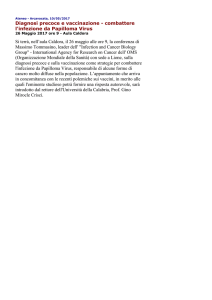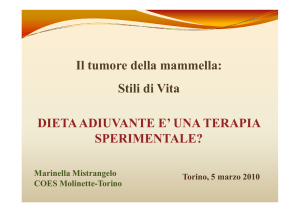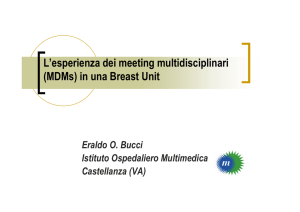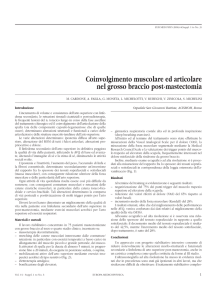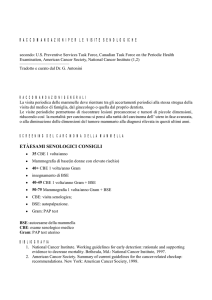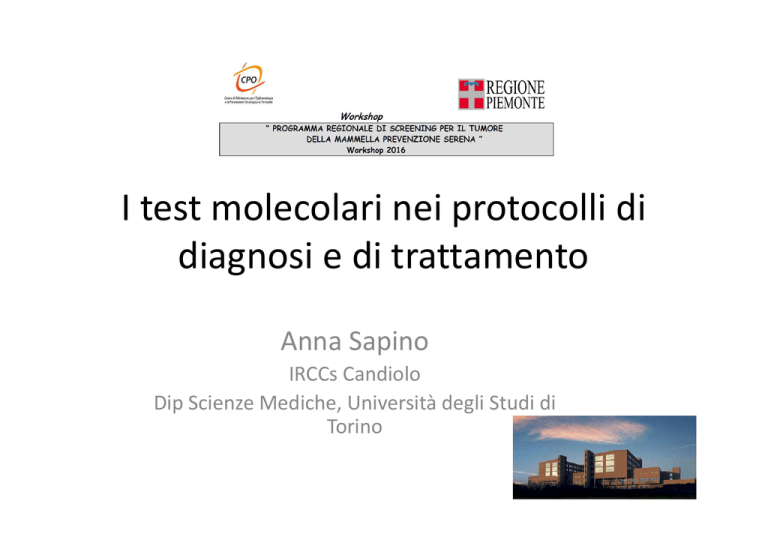
I test molecolari nei protocolli di
diagnosi e di trattamento
Anna Sapino
IRCCs Candiolo
Dip Scienze Mediche, Università degli Studi di
Torino
2016: Pathological report of breast cancer
MINIMAL REQUIREMENTS
Prognostic parameters
•
•
•
•
•
•
Invasive Carcinoma Histotype (NST, lobular, tubular etc);
Size (mm) [pT];
Grade (Elston and Ellis);
Lymph node status [pN];
Vascular invasion;
Surgical sample margin status.
Predictive parameters
Therapy
•
•
•
•
Endocrine +/- Chemotherapy
Estrogen Receptor (ER)
Progesterone Receptor (PR)
Proliferation Index (Ki67)
HER2
Target therapy+Chemotherapy
+/- Endocrine therapy
2016: Pathological report of breast cancer
MINIMAL REQUIREMENTS
Prognostic parameters
•
•
•
•
•
•
Invasive Carcinoma Histotype (NST, lobular, tubular etc);
Size (mm) [pT];
Grade (Elston and Ellis);
Lymph node status [pN];
Vascular invasion;
Surgical sample margin status.
Predictive parameters
Therapy
•
•
•
•
Endocrine +/- Chemotherapy
Estrogen Receptor (ER)
Progesterone Receptor (PR)
Proliferation Index (Ki67)
HER2
Target therapy+Chemotherapy
+/- Endocrine therapy
Molecular categories
ER+/HER2Evaluated on FFPE breast
cancer tissues
Gene expression profiling (GEP), using multivariate
models to predict an individual’s risk of recurrence,
has found a niche within molecularly distinct breast
cancer subgroups.
Journal of Clinical Oncology, Vol 30, No 18 (June 20), 2012: pp 2173-2174
Test
MammaPrint
(FDA approved)
van’t Veer LJ et al., Nature 2002
(ref.9)
Oncotype DX
Paik S et al., N Engl J Med 2004
(ref. 10)
Tecnica
Output/Score
qRT-PCR (21 geni)
Recurrence score (0-100): rischio di ricaduta
a distanza a 10 anni in pazienti ER-positivi, lnf
negativi:
- basso (<18)
- intermedio (18-31)
- alto (>31)
HOXB13: IL17R ratio stratifica il rischio di
ricaduta delle pazienti ER positive in:
-basso rischio
-alto rischio
Score continuo (0-100) di rischio di ricaduta a
distanza a 10 anni e sottotipo intrinseco:
Luminali A: basso; Luminali B1: intermedio;
Luminali B2: alto;
Basale: intermedio; HER2 enriched: alto
Rischio di ricaduta a 10 anni:
- low-risk tumors
- high-risk tumors
Rischio di ricaduta a 5-10 anni:
- low-risk tumors
- high-risk tumors
Microarray-based
gene expression
profiling (70 geni)
Theros-Breast Cancer Gene
Expression Ratio Assay
Ma XJ et al., Cancer Cell 2004
(ref. 11)
PAM50/Breast Bio Classifier
Parker JS et al., JCO 2009 (ref. 12)
qRT-PCR (3 geni)
Endopredict
Filipits M et al.,
Clin Cancer Res 2011 (ref. 13)
Breast Cancer Index
Sgroi DC. et al,
Lancet Oncol 2013 (ref. 14)
qRT-PCR (8 geni)
qRT-PCR (55 geni)
qRT-PCR (7 geni)
Rischio di ricaduta a 10 anni:
- basso-rischio (13%)
- alto-rischio (56%)
ITALIA
• NON SONO INSERITI NEI LEA
• NON SONO RIMBORSABILI
• SONO DI INTERESSE PER IL CLINICO?
• 90 breast cancers diagnosed at the Molinette Breast Unit (FebruaryOctober 2010).
•5 oncologists expert in breast cancer therapy blinded to the molecular
analysis
•
TESI DI LAUREA del Dr. Luca Molinaro
Richieste MPT
Molecolar test need
Number of cases
70
60
66
50
40
42
35
30
17
20
13
10
0
1
2
3
4
TESI DI LAUREA del Dr. Luca Molinaro
5
ITALIA
•
•
•
•
NON SONO INSERITI NEI LEA
NON SONO RIMBORSABILI
SONO DI INTERESSE PER IL CLINICO?
CRITERI PER L’APPLICABILITA’
Impact of Gene Expression Profiling Tests on
Breast Cancer Outcomes
Evidence Reports/Technology Assessments, No. 160
Investigators: Luigi Marchionni, MD, PhD, Renee F Wilson,
MSc, Spyridon S Marinopoulos, MD, MBA, Antonio C Wolff,
MD, Giovanni Parmigiani, MD, Eric B Bass, MD, MPH, and
Steven N Goodman, MD, MHS, PhD.
Rockville (MD): Agency for Healthcare Research and Quality
(US); 2008 Jan.
Genet Med 2009:11(1): 66 –73.
Key Question 1. What is the direct evidence that gene expression profiling tests
in women diagnosed with breast cancer (or any specific subset of this
population) lead to improvement in outcomes?
Key Question 2. What are the sources of and contributions to analytic validity
in these gene expression-based prognostic estimators for women diagnosed
with breast cancer?
Key Question 3. What is the clinical validity of these tests in women diagnosed
with breast cancer?
Key Question 4. What is the clinical utility of these tests?
Evidence Reports/Technology Assessments, No. 160
Key Question 3. What is the clinical validity of these tests in women diagnosed with breast
cancer?
•
Clinical validity defines the ability of the test to accurately and reliably identify or
predict the intermediate or final outcomes of interest. This is usually reported as clinical
sensitivity and specificity.
Genet Med 2009:11(1): 66 –73.
a.How well does this testing predict recurrence rates for breast cancer compared to
standard prognostic approaches? (e.g., tumor type or stage, age, ER, and human epidermal
growth factor receptor 2 (HER-2) status)?
b. Are there any other factors, which may not be components of standard predictors of
recurrence (e.g., race/ethnicity or adjuvant therapy), that affect the clinical validity of these
tests, and thereby generalizability of results to different populations?
Essentially nothing is known about how specific characteristics of these populations might
affect test performance.
Potential for Scale Problems : One problem that may be faced in the future is that of the
consequences of an increase in demand for these tests.
Whether the degree of accuracy seen in investigational settings can be maintained with
increasing demands should be monitored by scientific or regulatory bodies.
Evidence Reports/Technology Assessments, No. 160
J Clin Oncol ottobre 2016 DOI: 10.1200/JCO.2015.65.2289
Recommendations
• In addition to estrogen and progesterone receptors and human epidermal growth factor
receptor 2, the panel found sufficient evidence of clinical utility for the biomarker assays
Oncotype DX, EndoPredict, PAM50, Breast Cancer Index, and urokinase plasminogen activator
and plasminogen activator inhibitor type 1 in specific subgroups of breast cancer.
• No biomarker except for estrogen receptor, progesterone receptor, and human epidermal
growth factor receptor 2 was found to guide choices of specific treatment regimens.
• Treatment decisions should also consider disease stage, comorbidities, and patient
preferences.
The literature search performed for this guideline did not identify studies that examined the
clinical utility of biomarkers across ethnic, racial, or socioeconomic backgrounds.
NICE DEFINITION
Quality-adjusted life year (QALYS)
A measure of the state of health of a person or group in which the benefits, in
terms of length of life, are adjusted to reflect the quality of life. One QALY is
equal to 1 year of life in perfect health.
QALYs are calculated by estimating the years of life remaining for a patient
following a particular treatment or intervention and weighting each year with a
quality-of-life score (on a 0 to 1 scale).
It is often measured in terms of the person’s ability to carry out the activities of
daily life, and freedom from pain and mental disturbance.
Erni, Hans (1909- ) - 1946
Self Portrait with Molecular Structure

